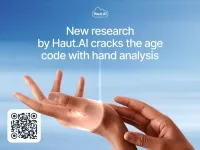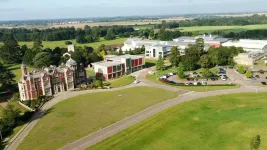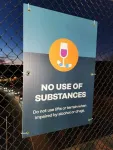(Press-News.org) The natural vein structure found within leaves – which has inspired the structural design of porous materials that can maximise mass transfer – could unlock improvements in energy storage, catalysis, and sensing thanks to a new twist on a century-old biophysical law.
An international team of researchers, led by the NanoEngineering Group at the Cambridge Graphene Centre, has developed a new materials theory based on ‘Murray’s Law’, applicable to a wide range of next-generation functional materials, with applications in everything from rechargeable batteries to high-performance gas sensors. The findings are reported in the journal Nature Communications.
Murray’s Law, put forward by Cecil D. Murray in 1926, describes how natural vascular structures, such as animal blood vessels and veins in plant leaves, efficiently transport fluids with minimum energy expenditure.
“But whereas this traditional theory works for cylindrical pore structures, it often struggles for synthetic networks with diverse shapes – a bit like trying to fit a square peg into a round hole,” says first author Cambridge PhD student Binghan Zhou.
Dubbed ‘Universal Murray’s Law’, the researchers’ new theory bridges the gap between biological vessels and artificial materials and is expected to benefit energy and environmental applications.
“The original Murray’s Law was formulated by minimising the energy consumption to maintain the laminar flow in blood vessels, but it was unsuited for synthetic materials,” says Binghan Zhou.
“To broaden its applicability to synthetic materials, we expanded this Law by considering the flow resistance in hierarchical channels. Our proposed Universal Murray’s Law works for the pores of any shape and suits all common transfer types, including laminar flow, diffusion, and ionic migration.”
Ranging from daily usage to industrial production, many applications involve ion or mass transfer processes through highly porous materials – applications that could benefit from Universal Murray’s Law, say the researchers.
For instance, when charging or discharging batteries, ions physically move between the electrodes through a porous barrier. Gas sensors rely on the diffusion of gas molecules through porous materials. Chemical industries often use catalytic reactions, involving laminar flow of reactants through catalysts.
“Employing this new biophysical law could greatly reduce the flow resistance in the above processes, boosting overall efficiency,” adds Binghan Zhou.
The researchers proved their theory using graphene aerogel, a material known for its extraordinary porosity. They carefully varied the pore sizes and shapes by controlling the growth of ice crystals within the material. Their experiments showed that the microscopic channels following the newly proposed Universal Murray’s Law offer minimum resistance against fluid flow, while deviations from this Law increase the flow resistance.
“We designed a scaled-down hierarchical model for numerical simulation and found that simple shape changes following the proposed Law indeed reduce the flow resistance,” says co-author Dongfang Liang, Professor of Hydrodynamics at the Department of Engineering.
The team also demonstrated the practical value of Universal Murray’s Law by optimising a porous gas sensor. The sensor, designed in accordance with the Law, shows a significantly faster response compared to sensors following a porous hierarchy, traditionally considered to be highly efficient.
“The only difference between the two structures is a slight variation in shape, showing the power and ease of application of our proposed Law,” says Binghan Zhou.
“We have incorporated this special natural Law into synthetic materials,” adds Tawfique Hasan, Professor of Nanoengineering at the Cambridge Graphene Centre, who led the research. “This could be an important step towards theory-guided structural design of functional porous materials. We hope our work will be important for new generation porous materials and contribute to applications for a sustainable future.”
The research was funded by the Engineering and Physical Sciences Research Council (EPSRC). Professor Hasan is a Fellow of Churchill College, Cambridge.
END
Bio-inspired materials’ potential for efficient mass transfer boosted by a new twist on a century-old theory
2024-05-07
ELSE PRESS RELEASES FROM THIS DATE:
Small pump for kids awaiting heart transplant shows promise in Stanford Medicine-led trial
2024-05-07
A small, implantable cardiac pump that could help children await heart transplants at home, not in the hospital, has performed well in the first stage of human testing.
The pump, a new type of ventricular assist device, or VAD, is surgically attached to the heart to augment its blood-pumping action in individuals with heart failure, allowing time to find a donor heart. The new pump could close an important gap in heart transplant care for children.
In a feasibility trial of seven children who received the new pump to support their failing hearts, six ultimately underwent heart transplants ...
Time flies, but your hands tell: Haut.AI cracks the age code with hand analysis
2024-05-07
Tallinn, Estonia – 7th May 2024, 10 AM CET – Haut.AI, a leader in responsible skincare artificial intelligence (AI) development, today announced a breakthrough research paper demonstrating the effectiveness of using hand images for accurate age prediction. This innovative approach offers a viable alternative to traditional facial photo methods and promotes fairer AI solutions.
The study, titled “Predicting human chronological age via AI analysis of dorsal hand versus facial images: A study in a cohort of Indian females,” shows that AI models trained on hand images achieve comparable accuracy to those using facial images, with an average error of ...
Babraham Institute receives £48M strategic investment from BBSRC for a four-year programme of work to promote lifelong health
2024-05-07
Following a quinquennial review by the Biotechnology and Biological Sciences Research Council (BBSRC), the Babraham Institute will receive £48m for the period 2024-2028 to advance research on the mechanisms that maintain the health of our cells, tissues and organs across the life course.
This work is key in driving BBSRC’s strategic research priorities around an integrated understanding of health, developing and applying transformative technologies and advancing our understanding of the rules of life.
As one of eight UK bioscience ...
Childhood sedentariness linked to premature heart damage – light physical activity reversed the risk
2024-05-07
An increase in sedentary time from childhood caused progressing heart enlargement, a new study shows. However, light physical activity could reduce the risk. The study was conducted in collaboration between the Universities of Bristol and Exeter, and the University of Eastern Finland, and the results were published in the prestigious European Journal of Preventive Cardiology.
Left ventricular hypetrophy refers to an excessive increase in heart mass and size. In adults, it is known to increase the risk for heart attacks, stroke, and premature death.
In the present study, 1,682 children ...
Parents’ watchful eye may keep young teens from trying alcohol, drugs: Study
2024-05-07
PISCATAWAY, NJ – Teenagers are less likely to drink, smoke or use drugs when their parents keep tabs on their activities--but not necessarily because kids are more likely to be punished for substance use, suggests a new study in the Journal of Studies on Alcohol and Drugs.
Researchers found that, contrary to common belief, parents’ “monitoring” does not seem to boost the odds of catching their kids using substances. However, when kids simply are aware that their parents are monitoring behavior, they avoid trying alcohol or drugs in the first place.
It is the fear of being caught, rather than actually being punished.
Many studies ...
A triumph of galaxies in three new images from the VST
2024-05-07
FOR IMMEDIATE RELEASE
Distant, far away galaxies. Interacting galaxies, whose shape has been forged by the mutual gravitational influence, but also galaxies forming groups and clusters, kept together by gravity. They are the protagonists of three new images released by the VLT Survey Telescope (VST).
VST is an optical telescope with a 2,6 diameter mirror, entirely built in Italy, that has been operating since 2011 at the European Southern Observatory’s (ESO) Paranal Observatory in Chile. Since 2022, the telescope has been fully managed by INAF through the National Coordination Centre for VST, ...
Smart labs for bespoke synthesis of nanomaterials are emerging
2024-05-07
In the early 20th century, the development of a catalyst for ammonia synthesis by the Haber-Bosch method took more than 10,000 experiments before it was successful. The development of new materials is a time-consuming and costly process from design to commercialization. However, in recent years, researchers have been working to shorten the development period by using artificial intelligence (AI). When combined with robots, it is possible to conduct material development research 24 hours a day, 365 days a year without human ...
The commercialization of CO2 utilization technology to produce formic acid is imminent
2024-05-07
CCU (Carbon Capture & Utilization), which captures CO2 and converts it into useful compounds, is crucial for rapidly transitioning to a carbon-neutral society. While CCS (Carbon Capture & Storage), which only involves CO2 storage, has entered the initial commercialization stage due to its relatively simple process and low operational costs, CCU has only been explored at the research level due to the complexity of conversion processes and high production costs of compounds.
Dr. Lee Ung's team at the Clean Energy Research Center ...
Multisite review shows serious adverse events occur frequently in outpatient care
2024-05-06
Embargoed for release until 5:00 p.m. ET on Monday 6 May 2024
Annals of Internal Medicine Tip Sheet
@Annalsofim
Below please find summaries of new articles that will be published in the next issue of Annals of Internal Medicine. The summaries are not intended to substitute for the full articles as a source of information. This information is under strict embargo and by taking it into possession, media representatives are committing to the terms of the embargo not only on their own behalf, but also on behalf of the ...
Study highlights need for improvement of patient safety in outpatient settings
2024-05-06
KEY TAKEAWAYS
In a study of outpatient sites, researchers found that 7% of patients experienced at least one adverse event and 1.9% of patients experienced at least one preventable adverse event.
The most common adverse events in the outpatient setting were adverse drug events.
The findings highlight an urgent need to develop interventions to prevent both inpatient and outpatient harm.
Over the last several decades, research has brought nationwide awareness to issues of patient harm in the “inpatient” setting, where patients ...






